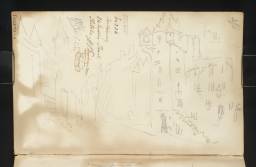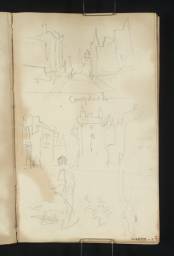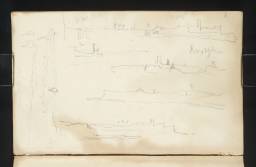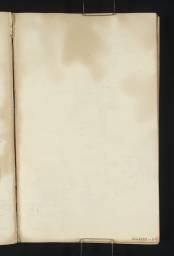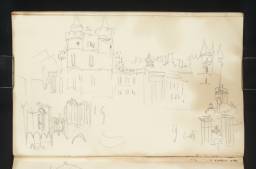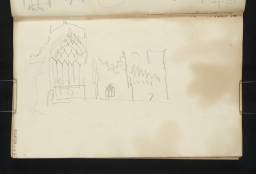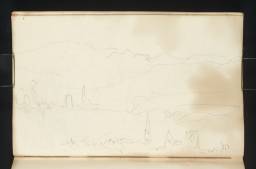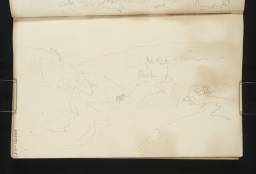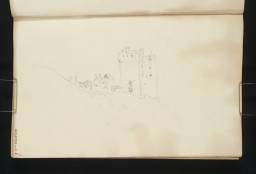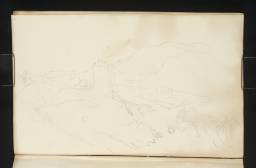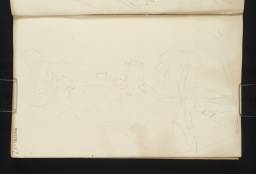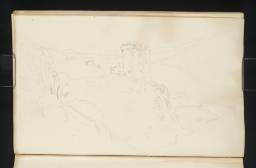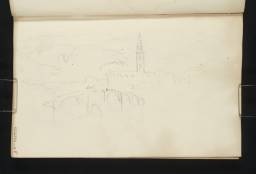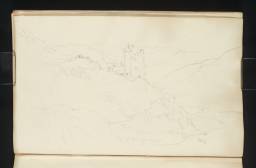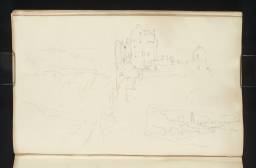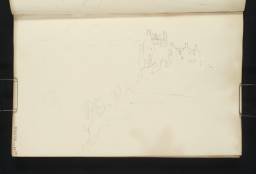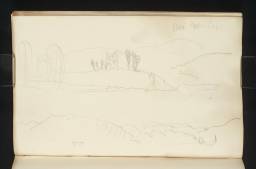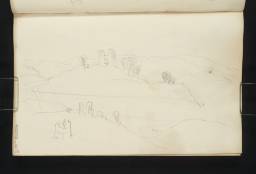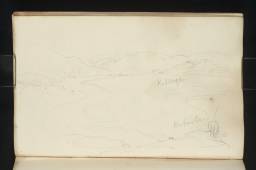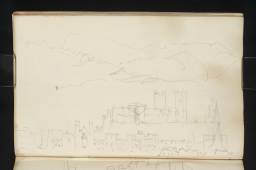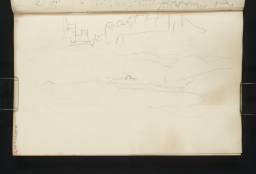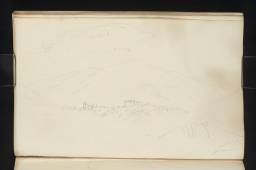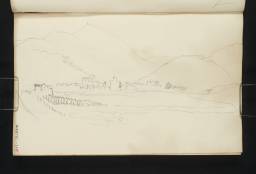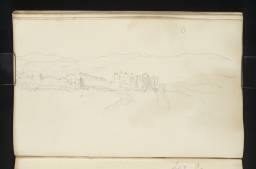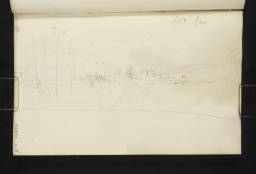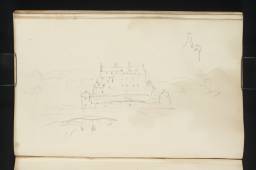Turner Bequest CCLXVIII
Sketchbook bound in red leather with three indented lines creating a border around the front and back covers. The inside front cover, folio 1 recto, folio 87 verso, the inside back cover and page edges are all marbled in orange and blue. Wallet-pockets at front and back; and leather strap on the back cover. Perhaps bound by Abraham Thomson, Edinburgh.
88 sheets of white wove paper made by an unknown Scottish maker watermarked ‘W & C | 1825’.
Approximate paper size 181 x 111 mm
Blindstamped with the Turner Bequest stamp at the centre of the front cover, and stamped in black ‘CCLXVIII’ at the top right of the front cover.
Stamped in black ‘CCLXVIII’ at the top left of the inside front cover, which also has a paper label stamped in black ‘Sold by JOHN THOMSON, | St. Andrew Square. | EDINBURGH.’ and inscribed in black ink ‘12: sheet.’
Numbered 236 as part of the Turner Schedule in 1854 and endorsed by the Executors of the Turner Bequest on folio 1 verso (D26096).
88 sheets of white wove paper made by an unknown Scottish maker watermarked ‘W & C | 1825’.
Approximate paper size 181 x 111 mm
Blindstamped with the Turner Bequest stamp at the centre of the front cover, and stamped in black ‘CCLXVIII’ at the top right of the front cover.
Stamped in black ‘CCLXVIII’ at the top left of the inside front cover, which also has a paper label stamped in black ‘Sold by JOHN THOMSON, | St. Andrew Square. | EDINBURGH.’ and inscribed in black ink ‘12: sheet.’
Numbered 236 as part of the Turner Schedule in 1854 and endorsed by the Executors of the Turner Bequest on folio 1 verso (D26096).
Accepted by the nation as part of the Turner Bequest 1856
Exhibition history
References
This is one of the three sketchbooks that Turner used on his tour of Scotland in 1834, undertaken in September and October in connection to a commission from the publisher Robert Cadell to sketch subjects to illustrate Sir Walter Scott’s Prose Works and Waverley Novels, and John Gibson Lockhart’s Memoirs of the Life of Sir Walter Scott (see Tour of Scotland for Scott’s Prose Works 1834 Tour Introduction). It was originally grouped together by A.J. Finberg with other sketchbooks used by Turner on his 1831 tour of Scotland.1 Gerald Finley has also treated the book as one of the 1831 group, though he has argued that it was reused for further sketches in 1834.2 The sketchbook has now been dated to 1834, thanks to the identification of a number of sketches that help piece together the 1834 tour, and which show that Turner returned in 1834 to several sites that he had previously seen and sketched in 1831. Therefore it can now be placed within the context of Turner’s 1834 Scottish tour.
The Edinburgh sketchbook was used during the last week of the tour and, according to the paper label on the inside front cover, was purchased in Edinburgh from the bookseller John Thomson of St Andrew Square. It is interesting to note that Robert Cadell, whose office was in St Andrew Square, purchased his journals from Thomson’s conveniently located shop, and it is likely that he gave this book to Turner because the artist had nearly filled the two books that he had brought with him to Scotland: the Loch Ard sketchbook (Tate D26667–D26747; Turner Bequest CCLXXII complete) and the Stirling and Edinburgh book (Tate D26259–D26435; D41047–D41049; Turner Bequest CCLXIX complete).
Turner’s relationship with Cadell is the key to identifying the sketches in this book and understanding their significance. The artist was in almost daily contact with Cadell while he was in Edinburgh, and some of his movements are recorded in the publisher’s daily journal entries.3
Turner arrived in Edinburgh on 15 September 1834 and stayed until the 18th, when he set off for Lanark and a tour to Glasgow, the Trossachs, Stirling, Kinross and Perth (Loch Ard sketchbook and Stirling and Edinburgh sketchbook), returning to Edinburgh by 29 September, when he had a meeting with Cadell.4 This sketchbook contains the sketches of the next six days, during which time Turner also used the Stirling and Edinburgh sketchbook.
On 29 and 30 October Cadell took Turner to sites associated with Scott’s life so that the artist could make sketches as the basis for potential illustrations to Lockhart’s Life of Scott. Having taken Turner to see Scott’s former home at Castle Street in Edinburgh on the 29th (Tate D26336; Turner Bequest CCLXIX 40a),5 Cadell took the artist the next day to Prestonpans to see another house where Scott had lived (folio 86; D26256), along with Prestonpans Church, Preston Tower (folio 83; D26251) and the battlefield of Prestonfield (folios 83 verso, 84; D26257, D26258), which featured in Scott’s novel Waverley.6
The artist met the publisher at the latter’s office the next morning, 1 October, and the two went together to Heriot’s Hospital (George Heriot’s School), which Turner sketched in exquisite detail (D26247; CCLXVIII 81), perhaps for the illustration to Scott’s novel, The Fortunes of Nigel. They then heading to Edinburgh Castle (D26218; CCLXVIII 63a), proceeding from there to the Grassmarket (folio 64; D26219) and onto Arthur’s Seat by way of the Royal Mile (folio 1; D26096).7 Turner stopped at St Anthony’s Chapel halfway up the hill to make a series of sketches from the popular viewpoint (Tate D26431; Turner Bequest CCLXIX 89a). It was probably on this occasion that he also made his sketches of Holyrood Palace and Abbey (folios 3 verso, 4; D26100, D26101). Returning to Cadell’s office at about three o’clock, the artist and publisher discussed the artist’s ‘proceedings tomorrow till Saturday’.8
There is no mention of Turner in Cadell’s diary on 3 or 4 October, suggesting that the artist was not in the city. However, a sequence of sketches that run in order from folio 4 verso (D26102) to 53 (D26198) with just a few interruptions record an excursion that would have taken about two days. Therefore it is possible to account for these days with a tour of the Scottish Borders around Peebles, Innerleithen, Selkirk and Melrose which was undertaken to collect material relating to Scott’s life and novels.9
His first sketches were at Peebles and nearby Neidpath Castle (D26103; CCLXVIII 5). From Peebles he travelled east to Innerleithen, taking the opportunity on the way to sketch the ruins of Horsburgh Castle (11 verso; D26115) and Cardrona Castle (folio 13; D26118). Just south of Innerleithen Turner seems to have taken a serious interest in Traquair House, the oldest continually inhabited house in Scotland, and supposedly the model for Tully-Veolan in Scott’s novel Waverley (17 verso; D26127).
He continued on the road south from Traquair, passing the farms at Kirkhouse (folio 20 verso; D26133) and Glenlude (folio 21; D26134) before turning west to reach the northern end of St Mary’s Loch (folio 24; D26140). The loch was the subject of a poem by Scott, and was later engraved for the frontispiece to one of the volumes of the Abbotsford edition of the collected Waverley Novels, though not after a design by Turner. The artist seems also to have been interested in the area’s connection to the poet James Hogg, and may even have made a quick sketch of the poet’s house, Altrive (folio 26 verso; D26145).
From St Mary’s Loch he turned east and followed the River Yarrow, passing the village of Yarrow (folio 34; D26160) before coming to Newark Castle (folio 37 verso; D26167). This was a familiar sight to Turner, who had visited the castle in 1831 to made sketches in preparation for an illustration to Scott’s Poetical Works (see Tour of Scotland for Scott’s Poetical Works 1831 Tour Introduction). Continuing east he passed Bowhill House (folio 39 verso; D26171) on his way to Philiphaugh and Selkirk (folio 40; D26172), which he had also seen in 1831. It may have been at Selkirk that Turner stayed the night of 2 October, if it was not at Peebles.
From Selkirk he travelled north to Galashiels (folio 42 verso; D26177), making a few sketches of the town with its many wool mills, before following the Gala Water to Abbotsford House on the River Tweed. Turner sketched the home of the late Sir Walter Scott (folio 52 verso; D26197), before heading to Chiefswood Cottage (folio 52; D26196) and Rhymer’s Glen (folio 50 verso; D26193) on the estate in preparation for illustrations to the Life of Scott. His final stop was at the town of Melrose, where he made a single sketch (folio 53; D26198), perhaps for the novel The Monastery, 1820, before returning to Galashiels and travelling onto Edinburgh.
Back in Edinburgh on 4 October, Cadell accompanied Turner ‘to Calton [Hill] to look at [the] South East corner for a monument to Sir Walter Scott.’10 Turner took the opportunity to make a series of sketches of Edinburgh from the hill, including some of the various monuments that were already on the site, perhaps as a comparison to the proposed Scott Monument (Tate D26411; Turner Bequest CCLXIX 79a). Turner did not depict the south-east corner, but he did sketch Princes Street from the hill, the eventual site of the monument, perhaps in order to consider what it would look like there.11 This seems to have been Turner’s last day in Edinburgh, as there is no further mention in Cadell’s diary of his presence in the city.
Gerald Finley has assumed that Turner coached from Edinburgh to Petworth in Sussex, where he is reported to have been in late September 1834 by Robert Leslie, the son of the painter C.R. Leslie.12 However, more recent research has indicated that 1836 is a more likely date for the subject of Leslie’s anecdote, and that according to the household accounts, Turner stayed at Petworth on 28 October to 5/6 November.13 Sketches of the coast at Leith (folio 85; D26254), Whitby (folio 77 verso: D26254) and Flamborough (folio 71; D26229) strongly suggest that Turner in fact returned south by sea. Sketches of Kent (folio 2 verso; D26098) raise the possibility that Turner travelled directly to Margate or Ramsgate by sea, though sketches of the Thames Estuary (folio 2 verso) indicate that he returned to London first.
There are just a few further sketches in this book that are unrelated to Turner’s Scottish tour and may have been made at a later date. These are two pages of vignette designs (folios 28 verso–29; D26149–D26150) and a page with three sketches made at London Bridge (folio 63; D26149).
The diary of Robert Cadell has therefore helped to date many of the sketches in this book to the day they were created. Subjects not mentioned by Cadell have now been identified, and can be matched to the days in which he does not mention Turner’s movements. When considered alongside the other two sketchbooks used in 1834, the itinerary of Turner’s tour in Scotland can be described in detail: see Tour of Scotland for Scott’s Prose Works 1834 Tour Introduction.
Finley 1980, pp.180, 181, 258 note 40, 259 note 42; Gerald Finley, ‘Scotland’, in Joll, Butlin and Herrmann 2001, pp.[1], 282.
For more about the Scott Monument and Turner’s opinion of it, see Gerald Finley, Landscapes of Memory: Turner as Illustrator to Scott, London 1980, pp.232–9 Appendix 2.
Finley 1980, p.183; Alexander J. Finberg, The Life of J.M.W. Turner, R.A. Second Edition, Revised, with a Supplement, by Hilda F. Finberg, revised ed., Oxford 1961, pp.348–50.
Technical notes
How to cite
Thomas Ardill, ‘Edinburgh sketchbook 1834’, sketchbook, March 2011, in David Blayney Brown (ed.), J.M.W. Turner: Sketchbooks, Drawings and Watercolours, Tate Research Publication, December 2012, https://www

